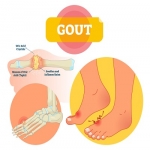There are many conditions out there that seem very similar in appearance, but when looking closely are very different. One of these types of issues is Rheumatoid Arthritis and Gout. When they effect a joint, they both can be very red, swollen, and painful. Knowing the difference helps in treating them. Management of both is imperative and can preserve the life of a joint for years to come.

What is gout
A form of arthritis that has been present since the beginning of human civilization. Gout is an over concentration of uric acid in the blood causing the urate crystals to accumulate in a specific joint causing pain. A common misconception is that it is a disease of overindulgence. Anyone can be affected by gout. The great toe is often considered the “classic” location but any joint can be affected. This may involve several joints or just one.
What is Rheumatoid Arthritis (RA)?

RA is an autoimmune disease that causes pain, stiffness, and destruction in the joints. When you have an autoimmune disease, the immune system which protects the body from invaders such as bacteria and viruses, misreads healthy tissue for a foreign invader. This affects all joints in your body, but sometimes different joints are affected with differing severity.

Gout Characteristics?
- Intensely painful, swelling of joints.
- Over concentration of uric acid in the blood. “This may happen because either uric acid production increases or, more often, the kidneys cannot remove uric acid from the body well enough.” (Rheumatology.org)
RA characteristics
Pain, swelling, and stiffness of joints. It can also show signs of loss of energy, fever or appetites. If left untreated, joint destruction and potentially organs can be affected.
Similarities-
Treatments and therapy exists, but there is no cure. You can also have a seemingly sudden onset of redness and pain.
Once the joints are affected by gout or RA the damage cannot be undone. The best course of treatment is preventative. Sometimes fusion, joint replacement or amputation is required.
With new medicines being developed, joint destruction has significantly decreased requiring less orthopedic intervention. The new medicines with guidance and monitoring of a Rheumatologist has significantly decreased and halted joint destruction.
Differences-
Gout more commonly affects men but also women who are post-menopausal.
Rheumatoid arthritis affects women more than men. A whopping 75% of patients are women.
How to Diagnose
There are several ways to diagnose gout depending on the stage the gout flair may be present. Initially location of the affected joints may direct the physician to diagnose gout. Another way to diagnose is by removing a sample of fluid from the affected joint by a needle and sending it off for labs. It is less predictable to diagnose blood samples even though that is often the first and easiest screening test used.

There are several different ways to diagnose Rheumatoid arthritis as well. Blood tests, x-rays and evaluation of organ function are some of the most commonly used. RA can sometimes be difficult to diagnose initially due to being an autoimmune disease. Being properly diagnosed often involves consultation with a Rheumatologist.
If you are suffering from a painful and swollen joint, do not hesitate to reach out to your general practitioner or orthopedist. They can direct and potentially treat your issue. They may also be able to get you in the door to the right specialist for your problem. Don’t suffer in silence. Your joints will thank you.


